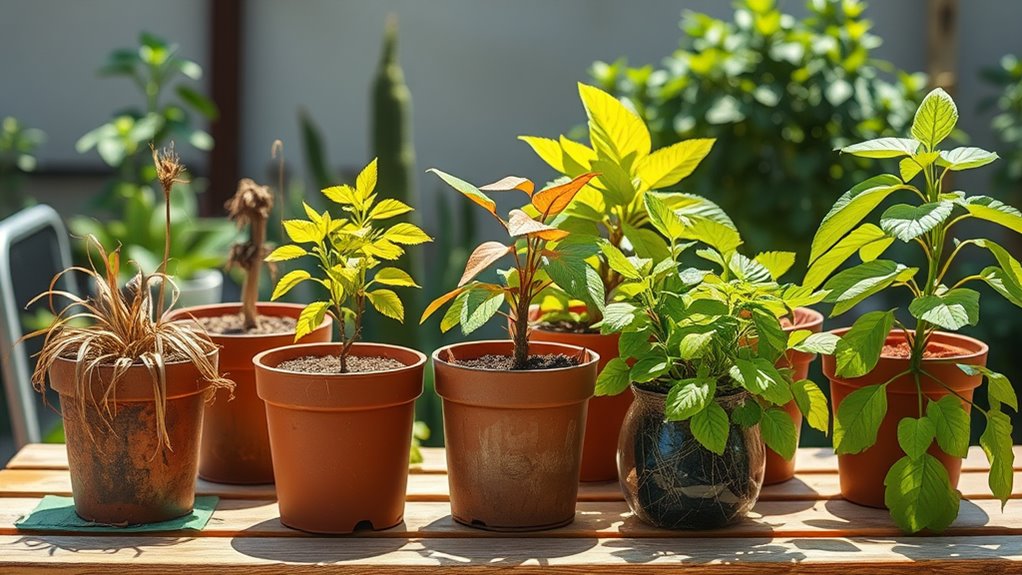7 Watering Mistakes You Don’t Know You’re Making
You’re making these 7 common watering mistakes without realizing it: overwatering, which yellows leaves and causes root rot; underwatering, leading to wilting and slow growth; watering at the wrong time, like midday evaporation; ignoring soil moisture checks; applying water inefficiently; neglecting plant-specific needs; and using the wrong tools. Correct these habits to keep your plants thriving—there’s plenty more advice just ahead.
Overwatering Your Plants
Have you ever noticed your plants’ leaves turning yellow or wilting despite regular watering?
Overwatering starves roots of oxygen, causing rot and stunted growth.
To fix this, follow these practical watering tips: check soil moisture with your finger before adding water, use pots with good drainage, and water only when the top inch feels dry. This prevents excess moisture, keeping your plants strong and thriving. Additionally, understanding optimal plant health can help you create a more effective watering routine.
Underwatering Without Realizing It
While overwatering can suffocate roots, underwatering sneaks up on you, leaving plants thirsty and weak.
You mightn’t realize you’re underwatering if you ignore signs like wilting leaves, dry soil, or slowed growth.
Regularly check soil moisture by feeling the top inch; water deeply when it’s dry to encourage strong roots.
Adjust based on plant type to prevent stress and maintain health. Additionally, consistent watering schedules can help ensure your plants receive the proper hydration they need.
Watering at the Wrong Time of Day
Watering at the wrong time of day can harm your plants by causing evaporation or fungal issues.
For example, if you’re watering midday, the sun quickly evaporates the moisture, leaving roots thirsty.
Instead, opt for early morning when temperatures are cooler, allowing water to penetrate deeply.
You’ll prevent leaf burn and fungal growth that thrives on overnight wetness, keeping your garden healthy and efficient. Additionally, watering during optimal times helps maximize absorption and minimizes waste, ensuring your plants receive the moisture they need.
Ignoring Soil Moisture Levels
You’ve probably overlooked soil moisture levels, leading to common watering errors that harm your plants.
Start by checking the soil’s moisture with a simple finger test or a moisture meter before you water.
This practice helps you prevent overwatering effects like root rot and wasted resources. Additionally, incorporating efficient watering tips into your routine can save both time and water while promoting plant health.
Check Soil Moisture
To check your plant’s soil moisture effectively, simply insert your finger into the soil up to the second knuckle and note its feel.
Feel if it’s dry, moist, or wet to guide your watering decisions accurately.
- Check for dry soil: If it feels completely dry, your plant needs watering immediately.
- Assess for moisture: If the soil is slightly damp, wait a few days before watering.
- Maintain consistency: Perform this check at the same time each week.
Prevent Overwatering Effects
Overwatering your plants by ignoring soil moisture can cause root rot and other issues, so you’ll want to recognize the signs early. You’ll notice symptoms like yellow leaves indicating excess water, or wilting despite wet soil, showing poor root health. Monitoring regularly helps prevent lasting damage. Here’s a table of common signs and actions:
| Sign of Overwatering | Preventive Action |
|---|---|
| Yellowing leaves | Let soil dry out |
| Wilting plants | Improve drainage |
| Mold growth | Remove affected areas |
| Slowed growth | Check soil compaction |
| Foul odor | Repot with fresh soil |
Act quickly to keep your plants thriving.
Applying Water Inefficiently
You often overwater your plants, leading to wasted resources and root damage. Choosing poor timing for watering, like during the hottest part of the day, causes evaporation and reduces absorption. To improve efficiency, consider adopting a watering schedule that aligns with the best times for plant hydration.
Overwatering Plants
Excessive watering can quickly damage plant roots by depriving them of oxygen, turning a simple task into a major setback for your garden.
This leads to root rot and poor growth, so you’ll need to stay vigilant.
-
Check soil moisture: Feel the top inch; water only if it’s dry to avoid saturation.
-
Improve drainage: Use pots with holes and well-draining soil to prevent water buildup.
-
Spot early signs: Watch for yellowing leaves or wilting as indicators you’re overwatering.
Poor Timing Choices
Timing your watering poorly, such as during peak heat, often wastes water and stresses plants unnecessarily.
Instead, you water early in the morning or late evening to reduce evaporation and facilitate deep root absorption.
This prevents runoff and fungal issues; you’ll conserve resources while promoting healthier growth.
Always check soil moisture first—don’t rely on schedules alone for efficiency.
Neglecting Plant-Specific Needs
Neglecting plant-specific needs often leads to watering errors, as each plant’s requirements vary based on factors like soil type, climate, and species.
It’s essential for you to personalize your approach for better results. Here’s how:
- Research each plant’s water needs based on its species and origin to avoid mismatches.
- Monitor soil moisture and plant signals, like wilting, to tailor your routine effectively.
- Adjust watering frequency according to the plant’s growth stage and local environment for best health.
Using the Wrong Watering Tools
Using the wrong watering tools can undermine your plant care efforts, leading to uneven moisture distribution or root damage. You’ll avoid this by selecting tools that match your plants’ needs for even watering. Here’s a practical comparison to visualize options:
| Tool | Best For | Potential Issue |
|---|---|---|
| Watering Can | Small plants or pots | Spillage if not aimed |
| Hose Sprayer | Gardens or lawns | Over-saturation |
| Drip Irrigator | Efficient automation | Clogs from debris |
| Mist Sprayer | Delicate foliage | Surface-only moisture |
| Soaker Hose | Rows of vegetables | Uneven ground flow |
Choose wisely to keep your plants healthy.

